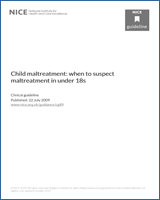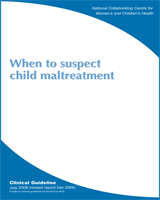3.1. Consider and suspect definitions
In general, there are two types of recommendation in this guidance and both are to be used in the context of differential diagnosis. The first is about considering child maltreatment as a possible explanation and is aimed at supporting the healthcare professional to recognise and act on considerations. The second is about suspecting maltreatment and may lead to a referral to children's social care. Indicators of maltreatment can coexist with organic disorders. The definitions below are key to understanding and using the remainder of the guidance as outlined in Chapters 4 to 8.
The guidance-specific definitions and associated actions have been derived from the collective clinical experience of GDG members informed by evidence identified in systematic searches and the views expressed in the Delphi consensus survey (see Section 2.11).
Definition of consider: For the purposes of this guidance, to consider child maltreatment means that maltreatment is a possible explanation for a report or clinical feature or is included in the differential diagnosis.
Definition of suspect: For the purposes of this guidance, to suspect child maltreatment means a serious concern about the possibility of child maltreatment but is not proof of it.
Definition of an unsuitable explanation: For the purposes of this guidance, an unsuitable explanation for an injury or presentation is one that is implausible, inadequate or inconsistent:
with the child or young person's:
- –
presentation
- –
normal activities
- –
existing medical condition
- –
age or developmental stage
- –
account compared to that given by parents and carers
between those given by the parents or carers
between accounts over time
because it is explained as cultural practice or religious belief since this should not justify hurting or harming a child or young person
3.2. How to use consider and suspect
Step 1. Listen and observe
Identification of child maltreatment involves piecing together information like parts of a jigsaw puzzle, with some pieces of information carrying more weight than others. All information should be considered critically and used by the healthcare professional to inform considered clinical suspicion in the context of possible differential diagnosis. The information that the healthcare professional should assess may originate from different sources and agencies. Information may also be gained from the careful assessment of alerting features observed in the child. Alerting features of maltreatment, either on their own or in combination, may include:
any history that is given
a report of maltreatment, or disclosure from a child or young person or third party (it is standard practice to refer to children's social services when a child or young person makes a disclosure of maltreatment, even though it may not be precise in every detail)
the child's appearance
the child's behaviour or demeanour
symptoms
physical signs
a result of an investigation
interaction between the parent or carer and child or young person.
Step 2. Seek an explanation
Seek an explanation for any injury or presentation from both the parent/carer and the child or young person unless the child or young person is not at a developmental stage to give an account or it is considered inappropriate or not possible to obtain an account.
Suspect maltreatment if you receive a disclosure or report from a child even though the child's account may not be precise in every detail. The professional should explain to the child the need to discuss this with another appropriate professional and the fact that they cannot keep this confidential.
Disability
The alerting features of maltreatment in children with disabilities may also be features of the disability, thus making identification of maltreatment more difficult. Appropriate expertise should be sought by healthcare professionals when they are concerned about a child or young person with a disability. Additional needs such as physical, sensory or learning disabilities should also be taken into account
Step 3. Record
Record in the child or young person's clinical record:
exactly what you observe and hear from whom and when
what, in your opinion, is of concern.
At this point, the healthcare professional may consider, suspect or exclude child maltreatment from the differential diagnosis.
Step 4. Consider, suspect or exclude maltreatment
Consider
At any stage during the process of considering maltreatment, the level of concern may change and lead to exclude or suspect maltreatment.
When hearing about or observing an alerting feature in the guidance, look for other alerting features of maltreatment in the child or young person's history, presentation or parent or carer interaction with the child or young person now or in the past.
Then do one or more of the following:
discuss your concerns with a more experienced colleague, a community paediatrician, a child and adolescent mental health service colleague, or a named or designated professional for safeguarding children
gather collateral information from other agencies and health disciplines, having used professional judgement about whether to explain the need to gather this information for an overall assessment of the child
ensure review of the child or young person at a date appropriate to the concern, looking out for repeated presentations of this or any other alerting features.
Suspect
If an alerting feature or the process of considering child maltreatment leads a healthcare professional to suspect child maltreatment, they should refer the child or young person to children's social care, following Local Safeguarding Children Board procedures.
This may trigger a child protection investigation, supportive services may be offered to the family following an assessment or alternative explanations may be identified.
Exclude
Exclude maltreatment when a suitable explanation is found for alerting features. This may be the decision following discussion of the case with a more experienced colleague or after gathering collateral information, or following review as part of considering child maltreatment.
Step 5. Record
Record all actions taken in step 4 and the outcome.
3.3. Communicating with and about the child or young person
Good communication between healthcare professionals and the child or young person, as well as with their families and carers, is essential. Communication should take into account additional needs such as physical, sensory or learning disabilities, or the inability to speak or read English. Consideration should be given to cultural needs of children or young people and their families and carers.
There are Local Safeguarding Children Board procedures for safeguarding children. If healthcare professionals have concerns about sharing information with others, they should obtain advice from named or designated professionals for safeguarding children. If concerns are based on information given by a child, healthcare professionals should explain to the child when they are unable to maintain confidentiality, explore the child's concerns about sharing this information and reassure the child that they will continue to be kept informed about what is happening. When gathering collateral information from other disciplines within health and other agencies, professionals need to use judgement about whether to explain to the child, young person and/or parent/carer the need to gather this information for the overall assessment of the child.


